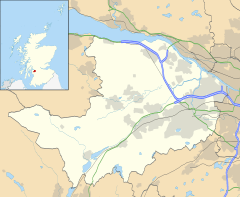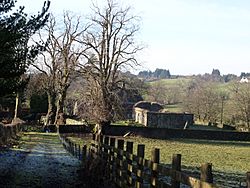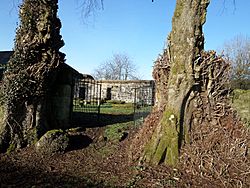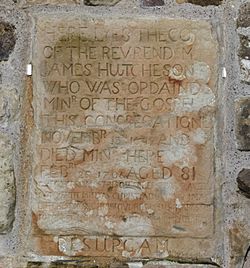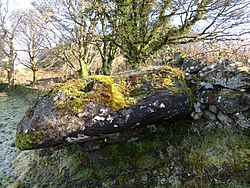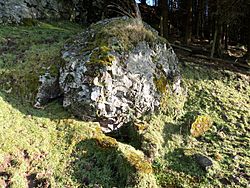St Fillan's Kirk, Seat and Well facts for kids
Quick facts for kids St Fillan's Kirk, Seat and Well
|
|
|---|---|
| OS grid reference | NS 38261 68936 |
| Civil parish |
|
| Council area | |
| Lieutenancy area | |
| Country | Scotland |
| Sovereign state | United Kingdom |
| Postcode district | PA6 |
| Dialling code | 01505 |
| Police | Strathclyde |
| Fire | Strathclyde |
| Ambulance | Scottish |
| EU Parliament | Scotland |
| UK Parliament |
|
| Scottish Parliament |
|
St Fillan's Kirk, Seat and Well are historic sites located in a small Scottish hamlet called Kilallan. This area was once an important religious center. The main church, or kirk, was abandoned long ago, but its ruins still stand today.
The ruins of the kirk and its graveyard are now protected as important historical sites. They are located about four miles west of the town of Houston.
Contents
The Story of St Fillan's Kirk
The name of the area, Kilallan, has been spelled in many different ways over the centuries, such as Kilfillan and Kilellan. The name comes from a holy man named St Fillan, who lived around the 7th century.
St Fillan was a follower of Saint Columba, another famous Scottish saint. His name in the Gaelic language means "little wolf." He was so respected that one of his arm bones was carried as a holy relic before the Scottish army at the famous Bannockburn.
In 1169, a powerful lord named Walter fitz Alan gave the church to Paisley Abbey. There are several other places in Scotland named after St Fillan, including wells and other churches. He is known as the patron saint of people with mental illnesses.
A Secret Meeting Place
In the 1700s, the kirk was used by a group called the Cameronians. They were a group of Covenanters, who were Scottish people with strong religious beliefs that sometimes clashed with the king's rules.
Because of this, they often had to meet in secret, remote places like Kilallan. These secret meetings were called Conventicles.
The Old Kirk and its Graveyard
The modern parish of Houston and Killellan was formed in 1771 when two smaller parishes joined together. After this, the old kirk at Kilallan was no longer needed and was abandoned.
The ruins have a special section called the Barochan Aisle. This was the burial place for the Fleming family, who lived in the nearby Barochan Castle.
Although one stone on the ruin is dated 1635, the building is much older. Its simple rectangular shape suggests it could date back to the 10th or 11th century. In 2005, the ruins were given to the Kilallan Kirk Preservation Trust, which now takes care of them. Every year, a special church service is held among the ruins.
Over the years, the church was changed. Old doorways were blocked up, sometimes using old gravestones. A new door was added in 1635. To the left of this door is a square hole where the parish jougs were once kept. Jougs were iron collars used for public punishment, but the ones from Kilallan were stolen long ago.
The Church Bell
The church bell was made in 1618. It was later taken from the kirk and hung in a tree at Barochan House, where it was rung every day. Today, the bell is kept in the modern parish church. It is rung once a year before the special service at the ruins.
Treasures Found in the Ruins
Some interesting items have been discovered among the ruins. These include a bronze coin from the 6th century and a medieval pewter crucifix. A piece of a knight's gravestone, showing part of a sword, was also found built into one of the walls.
The Minister's House
Next to the church is a building now called Kilallan Farm. This was the church's manse, or minister's house. It is thought to be the oldest house still standing in the county of Renfrewshire. It even had a loupin stane, which is a block of stone used to help the minister get onto his horse.
A Minister and the Paisley Witch Trials
A plaque on the church wall remembers Reverend James Hutcheson, who was the minister here from 1649 until 1706.
He is known for his role in the famous Paisley witches affair of 1697. During this time, an 11-year-old girl named Christian Shaw accused several people of witchcraft. Reverend Hutcheson preached a powerful sermon against witchcraft just before the trials began. Sadly, several people were found guilty and punished because of the girl's stories.
St Fillan's Seat
Near the kirk is a large block of stone known as St Fillan's Seat or St Fillan's Chair. It is a natural boulder with a hollow that looks like a seat.
Legend says that St Fillan himself sat here to preach to people. It is also said he baptised new followers here, using holy water from the nearby well. Another story claims that sitting on the chair could cure rheumatism, a condition that causes painful joints.
St Fillan's Well
St Fillan's holy well is a spring that flows from under a large rock. Its water was believed to have healing powers, especially for sick children.
In the past, people would tie pieces of cloth to branches hanging over the well. These were offerings left in hope of a cure. This type of well is sometimes called a clootie well.
Around 1690, Reverend Hutcheson, who disliked these old traditions, had the well filled with stones. However, the water kept flowing, and the well was later cleared out.
The Barochan Cross
The Barochan Cross is a beautifully carved Celtic cross from the 8th or 9th century. It used to stand near Kilallan on an old trackway. Today, to protect it from the weather, it is kept inside Paisley Abbey.
See also
- Kirkbride, Durisdeer
- St Peter's Well, Houston
- St Margaret's Well, Edinburgh


